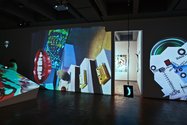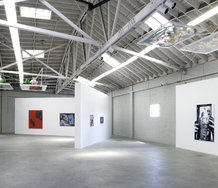Laura Brown – 8 October, 2013
Chicks on Speed seem interested in the possibilities that lie in using technologies (of all forms and age) for engaging their audiences and challenging the whiteness (literally and otherwise) of the cube. This seems rather to come out of a DIY attitude with an obsession for developing a voice and a language that reaches beyond, and in doing so hopefully expands, the strict category of contemporary art.
Chicks on Speed are a multi-national and multi-disciplinary group of artists who have been producing projects together since 1997. For the IMA they present SCREAM, a large-scale immersive installation that expands against one large room and into another smaller room that seems to function as its annex. In this main room, multiple moving projections are cast against the fours expansive walls, and against a heap of carefully upturned and leaning plinths that offer some variation in the otherwise flat surface of these projections. Walking in, the show proffers an assault of moving colour and non-specifically reverberating sound that might just as easily enthral or trigger disengagement.
The logic, and indeed the purpose, of a show like this lies in a belief of the positive potential of audience interaction. A number of iPads swing from the ceiling, invite anybody to remix the music, draw across the walls, and insert your own imagery with a live video feed (or indeed turn the sound down and wipe clean the visual slate altogether, leaving only videos of Chicks on Speed dancing in their own silent, abstracted video world). Perhaps this visceral, visual assault, and the control offered over it, is meant to offer a sort of catharsis from, or within, the structure of the ‘art museum’, wanting its viewer to interfere: make your own noise, draw and write things, move light and colour, play!
In the second smaller room, the one with the lights on, we might see a different kind of outcome of this method, with a number of smaller propositions, like an interactive tapestry presented on a stand, or a shoe-guitar encased safely upon a plinth. Here we see objects that could be read as both imagined potential results of this lively new space, and as real artefacts that have come out of this method. That is, as a kind of suggestion toward the outcome that the artists hope for from their imagined wide open audience?
As an installation, SCREAM seems almost to fetishise new technology, with its myriad interactive iPad apps and similar clever tricks. Though more than this, Chicks on Speed seem more interested in the possibilities that lie in using technologies (of all forms and age) for engaging their audiences and challenging the whiteness (literally and otherwise) of the cube, as they have been doing for the past 15+ years of their practice. Rather than being symptomatic of any obsession with the newness of technology, this seems rather to come out of a DIY attitude with an obsession for developing a voice and a language that reaches beyond, and in doing so hopefully expands, the strict category of contemporary art.
It’s an open, clamouring proposition - with suggestions for use - in the hope that something freer might occur in the gallery space, coming from a group of artists who themselves work more broadly across the contexts of visual art, fashion, and music. It is the kind of work most often seen in a biennale context, where innumerable large-scale or off-site spaces are offered to artists to present work that hopefully challenges its viewer to reconsider the context and function of this space, to usurp the assumed authority that lies behind the hard white cube - but though by now has established its own kind of authoritative voice.
This kind of work, in the frame of other recent shows at the IMA, could be compared to the giant assault of light and sound that was Marco Fusinato‘s. Though this installation was far less an ‘interactive work’ than it was an outright aggressive spectacle that demanded a response from its viewer. Though perhaps, being one in of the comparatively small ratio of women artists presented in the IMA’s programming, SCREAM had the job of doing all of the above, at the cost of coming across as somewhat distracted, at once.
Laura Brown









 Two Rooms presents a program of residencies and projects
Two Rooms presents a program of residencies and projects Advertising in this column
Advertising in this column



This Discussion has 0 comments.
Comment
Participate
Register to Participate.
Sign in
Sign in to an existing account.